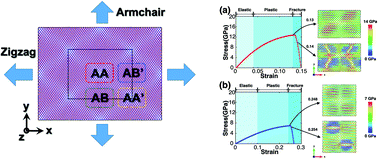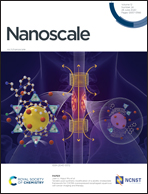Twistronics in tensile strained bilayer black phosphorus†
Abstract
In this work, by performing state-of-the-art first-principles methods combined with molecular dynamic (MD) simulation, we theoretically investigate the electronic and mechanical behaviours of small-angle twisted bilayer black phosphorus (tbBP) under uniaxial tensile deformation. Twistronics, namely the regulation of electronic properties by Moiré physics, is demonstrated as the gene – the most crucial factor dominating not only electronic behaviour but also mechanical behaviour of tensile deformed tbBP. Compared to untwisted few-layer black phosphorus (utBP) with strong electronic sensitivity to geometric deformation, the existence of Moiré patterns in tbBP leads to spatial electronic localization, giving rise to the conservation of direct band gaps and stability of phonon limited carrier mobility under tensile deformation along the armchair direction. Moreover, during the fracture failure process, the nucleation of micro-cracks is preferentially detected at the transitional pattern boundary areas in tbBP, which could be attributed to the intra-layer maldistribution of mechanical strengths in Moiré superlattices. The explorations of twistronics in tensile strained bilayer black phosphorus contribute to the better understanding of such Moiré superlattice structures and provide insights for the design of new 2D van der Waals heterostructures in flexible nano-electronic devices.



 Please wait while we load your content...
Please wait while we load your content...